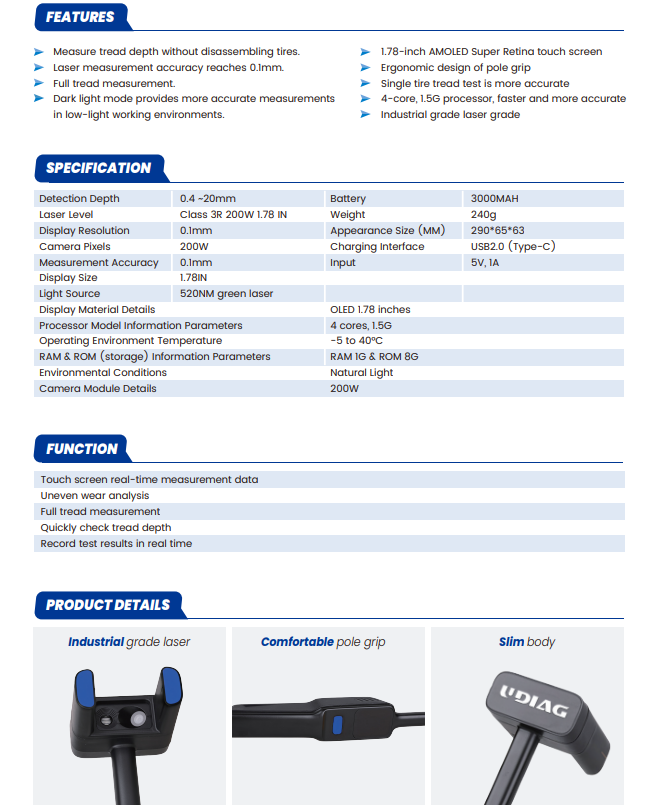Are tire tread detectors capable of identifying tire wear patterns or irregularities?
2024-03-20 by UDIAG
Tire tread detectors have emerged as vital tools in enhancing road safety by identifying tire wear patterns and irregularities. As vehicles traverse roads, tires undergo continuous wear and tear, which, if left undetected, can lead to performance issues and safety hazards. Tire tread detectors play a crucial role in early identification of wear patterns, thereby enabling timely maintenance interventions. This essay explores the capabilities of tire tread detectors in identifying tire wear patterns and irregularities, their significance, applications, challenges, and future prospects.

I. Tire Wear Patterns
Tire wear patterns such as center wear, edge wear, cupping, and feathering are common occurrences resulting from various factors like misalignment, improper inflation, and road conditions. Detecting these patterns visually is challenging and often leads to oversight. However, tire tread detectors equipped with advanced sensor technology can accurately detect these patterns, facilitating proactive maintenance measures. Early identification of wear patterns is essential as it prevents further deterioration of tires, ensuring optimal vehicle performance and safety.
II. Capabilities of Tire Tread Detectors
Tire tread detectors employ sophisticated sensor technology and data analysis methods to detect wear patterns and irregularities accurately. These detectors collect data on tread depth and analyze it to identify deviations from expected patterns. The accuracy and reliability of detection offered by tread detectors surpass traditional manual inspection methods. Moreover, these detectors can be integrated into vehicle systems, providing real-time feedback to drivers and fleet managers, enabling prompt action.
III. Factors Affecting Detection Accuracy
Several factors influence the accuracy of tire tread detection, including tire design, environmental conditions, sensor calibration, and integration with vehicle systems. Variations in tire design and materials may affect detection accuracy. Environmental factors such as temperature and road surface conditions can also impact the performance of tread detectors. Proper sensor calibration and maintenance are crucial to ensuring consistent and reliable detection results. Integration with vehicle systems requires seamless compatibility and synchronization to provide actionable insights.
IV. Applications of Tire Tread Detectors
Tire tread detectors find applications across various sectors, including the automotive industry, fleet management, and road safety initiatives. In the automotive industry, tread detectors aid in quality control during tire manufacturing and enable predictive maintenance in vehicles. Fleet managers utilize tread detectors to monitor tire health across their fleets, optimizing tire usage and reducing maintenance costs. Road safety initiatives leverage tread detectors to enforce regulations and ensure compliance with tread depth requirements, enhancing overall road safety.
V. Future Trends and Developments
The future of tire tread detection is promising, with advancements in sensor technology and integration with autonomous vehicle systems. Emerging sensor technologies offer higher precision and reliability in detecting tire wear patterns. Integration with autonomous vehicle systems enables real-time monitoring and adaptive tire management strategies, further enhancing safety and efficiency on the roads. Additionally, ongoing research and development efforts aim to address current challenges and improve the performance of tread detectors in diverse operating conditions.
VI. Challenges and Limitations
Despite their benefits, tire tread detectors face challenges such as cost considerations, compatibility issues, reliability in extreme conditions, and regulatory compliance. The initial investment required for implementing tread detection systems may deter widespread adoption, particularly in smaller fleets or low-income regions. Ensuring compatibility with various tire types and sizes presents technical challenges that require innovative solutions. Reliability in extreme conditions, such as severe weather or off-road environments, remains a concern. Regulatory standards and compliance requirements also influence the adoption and implementation of tread detection systems.
Conclusion
In conclusion, tire tread detectors play a pivotal role in enhancing road safety by accurately identifying tire wear patterns and irregularities. Their capabilities in early detection enable timely maintenance interventions, optimizing vehicle performance and safety. Despite facing challenges, tire tread detectors hold immense potential in advancing road safety initiatives and shaping the future of transportation. Continued research, technological advancements, and collaborative efforts are essential to overcome existing limitations and realize the full benefits of tread detection systems.
Get Access Now: https://www.udiagtech.com
FAQs
1. What are tire tread detectors, and how do they work?
Tire tread detectors are devices equipped with sensors that analyze the tread depth of tires. They work by measuring the depth of the tire tread and comparing it to predetermined thresholds or patterns to identify wear irregularities.
2. Why are tire tread detectors important?
Tire tread detectors are important because they help in early detection of tire wear patterns and irregularities, which can affect vehicle performance and safety. By identifying these issues early, they enable timely maintenance interventions, reducing the risk of accidents and optimizing tire lifespan.
3. What types of tire wear patterns can tire tread detectors identify?
Tire tread detectors can identify various wear patterns, including center wear, edge wear, cupping, and feathering. These patterns may indicate issues such as misalignment, improper inflation, or suspension problems, which can affect tire performance and safety.
4. How accurate are tire tread detectors in identifying wear patterns?
The accuracy of tire tread detectors in identifying wear patterns depends on factors such as sensor technology, calibration, and environmental conditions. Advanced detectors equipped with precision sensors and sophisticated data analysis algorithms can provide high levels of accuracy.
5. Can tire tread detectors be integrated into vehicles or fleet management systems?
Yes, tire tread detectors can be integrated into vehicles or fleet management systems to provide real-time monitoring of tire health. Integration allows for proactive maintenance scheduling, optimization of tire usage, and cost reduction in fleet operations.
6. What are the benefits of using tire tread detectors in road safety initiatives?
Using tire tread detectors in road safety initiatives helps enforce regulations related to tread depth requirements. By identifying worn tires early, these detectors contribute to reducing accidents caused by tire-related issues and promote overall road safety.


